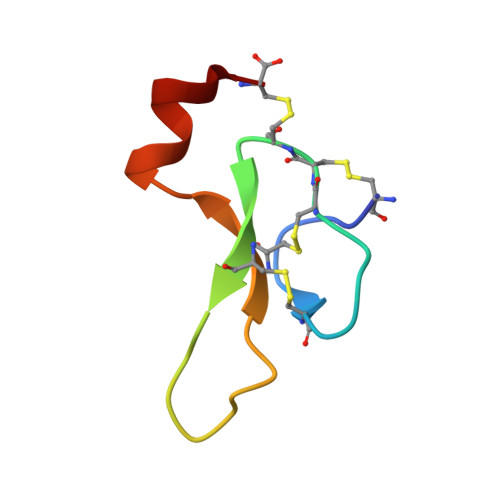The structure of versutoxin (delta-atracotoxin-Hv1) provides insights into the binding of site 3 neurotoxins to the voltage-gated sodium channel.
Fletcher, J.I., Chapman, B.E., Mackay, J.P., Howden, M.E., King, G.F.(1997) Structure 5: 1525-1535
- PubMed: 9384567
- DOI: https://doi.org/10.1016/s0969-2126(97)00301-8
- Primary Citation of Related Structures:
1VTX - PubMed Abstract:
Versutoxin (delta-ACTX-Hv1) is the major component of the venom of the Australian Blue Mountains funnel web spider, Hadronyche versuta. delta-ACTX-Hv1 produces potentially fatal neurotoxic symptoms in primates by slowing the inactivation of voltage-gated sodium channels; delta-ACTX-Hv1 is therefore a useful tool for studying sodium channel function. We have determined the three-dimensional structure of delta-ACTX-Hv1 as the first step towards understanding the molecular basis of its interaction with these channels. The solution structure of delta-ACTX-Hv1, determined using NMR spectroscopy, comprises a core beta region containing a triple-stranded antiparallel beta sheet, a thumb-like extension protruding from the beta region and a C-terminal 310 helix that is appended to the beta domain by virtue of a disulphide bond. The beta region contains a cystine knot motif similar to that seen in other neurotoxic polypeptides. The structure shows homology with mu-agatoxin-I, a spider toxin that also modifies the inactivation kinetics of vertebrate voltage-gated sodium channels. More surprisingly, delta-ACTX-Hv1 shows both sequence and structural homology with gurmarin, a plant polypeptide. This similarity leads us to suggest that the sweet-taste suppression elicited by gurmarin may result from an interaction with one of the downstream ion channels involved in sweet-taste transduction. delta-ACTX-Hv1 shows no structural homology with either sea anemone or alpha-scorpion toxins, both of which also modify the inactivation kinetics of voltage-gated sodium channels by interacting with channel recognition site 3. However, we have shown that delta-ACTX-Hv1 contains charged residues that are topologically related to those implicated in the binding of sea anemone and alpha-scorpion toxins to mammalian voltage-gated sodium channels, suggesting similarities in their mode of interaction with these channels.
Organizational Affiliation:
Department of Biochemistry University of Sydney Sydney, NSW 2006, Australia.














